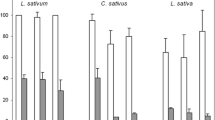Abstract
Seed tubers were treated by incubation of cut surfaces in solutions of 0.5%, 2,3,5-triphenyl tetrazolium chloride (TZ) for 30 or 90 min. Reaction rate, measured as change in surface reflectance (R/hr) and distance of transport in vascular tissue (mm/hr), were significantly correlated with tuber aging due to time (1, 2, 3 years) or temperature treatments and with sprout number per tuber. TZ results were significantly correlated with yield of U.S. no. 1 tubers in field tests. It was proposed that TZ be used in seed tuber testing and as a cytochemical probe in physiological studies.
Resumen
Se trataron tubérculos-semillas incubando superficies de corte en soluciones de 0.5/ de cloruro de tetrazolio 2,3,5-trifenil (TZ) durante 30 ó 90 minutos. La tasa de reacción, medida como cambio de la superficie en capacidad reflectante (reflectancia) (R/h), y la distancia de transporte en tejido vascular (mm/h), estaban significativamente correlacionadas con el envejecimiento del tubérculo debido al tiempo (1,2,3 años) o a tratamientos de temperatura. Los resultados del TZ estaban significativamente correlacionados con el número de brotes por tubérculo y con el rendimiento de tubérculos de primera calidad según la norma de los Estados Unidos. Se propone que se utilice la prueba de TZ como prueba citoquímica en estudios fisiológicos.
Similar content being viewed by others
Literature Cited
Artschwager, E. 1924. Studies on the potato tuber. J Agric Res 27:809–835.
Black, M.M. and I.S. Kleiner. 1949. The use of triphenyltetrazolium chloride for the study of respiration in plant tissue slices. Science 110:660–661.
Cinki, S. and T.M. Ching. 1965. Correlations of the tetrazolium test with germination tests of wheat stored under different conditions. Agron J 57:287–288.
Cutter, E.G. 1978. Structure and development of the potato plant. InThe Potato Crop. P.M. Harris, editor. Chapman and Hall, London.
Dianzani, M.U. 1953. Histochemical detection with ditetrazolium chloride of some enzymatic activities in isolated mitochondria. Nature 171:125–126.
Dufremoy, J. and R. Pratt. 1949. Histo-physiological localization of the sites of reducing activity in stalks of sugar cane. Am J Bot 35:333–334.
Grabe, D.F. 1970.Tetrazolium Testing Handbook for Agricultural Seeds. Contr. 29 toThe Handbook on Seed Testing. Assoc. of Official Seed Analysts.
Iritani, W.M. 1967. Some factors affecting productivity of Russet Burbank seed potatoes. Am Potato J 44. 153–158.
Iritani, W.M. 1968. Factors affecting physiological aging (degeneration) of potato tubers used as seed. Am Potato J 45:111–116.
Kawakami, K. 1962. The physiological degeneration of potato seed tubers and its control. Eur Potato J 5:40–49.
Kawakami, K. 1963. The physiological degeneration of potato seed tubers and its control. Am Potato J 40:25–29.
Kingman, G.C. 1959. Wild garlic bulblet viability determined by 2,3,5-triphenyl tetrazolium chloride. Weeds 7:474–480.
Krijthe, N. 1958. Changes in the germination powers of potatoes from the time of lifting onwards. Eur Potato J 1:69–72.
Krijthe, N. 1962. Observations on the sprouting of seed potatoes. Eur Potato J 5:316–333.
Metzler, D.E. 1977.Biochemistry, the Chemical Reactions of Living Cells. p. 590. Academic Press, N.Y.
Morse, R.E. 1949. Triphenyl tetrazolium chloride as an indicator reagent for blanching. Fruit Prod J 29:13–14, 25.
Parker, J. 1952. Desiccation in conifer leaves. Anatomical changes and determination of the lethal level. Bot Gaz 114:189–198.
Perl, M., I. Luria, and H. Gelmond. 1978. Biochemical changes in sorghum seeds affected by accelerating aging. J Exp Bot 29:497–509.
Roberts, L.W. 1951. Survey of factors responsible for reduction of 2,3,5-triphenyl tetrazolium chloride in plant meristems. Science 113:692–693.
Roistacher, C.M., J.G. Gald, and K.F. Baker. 1953. The tetrazolium test for dormancy and germinability of gladiolus cormels. Science 118:186–187.
Smith, F.G. 1951. The mechanism of the tetrazolium reaction in corn embryos. Plant Physiol 27:445–456.
Waugh, T.D. 1948. Staining of the stem tissues of plants by triphenyl tetrazolium chloride. Science 107:275.
Wurr, D.C.E. 1978. ‘Seed’ tuber production and management pp. 327–352. InThe Potato Crop: The Scientific Basis for Improvement. P.M. Harris, ed. Chapman and Hall, London.
Author information
Authors and Affiliations
Additional information
Scientific paper no. 6358. Washington State Univ. College of Agriculture Research Center, Pullman, WA Project 6949.
Rights and permissions
About this article
Cite this article
Sacher, R.F., Iritani, W.M. Tetrazolium tests as indicators of tuber physiological age and yield potential. American Potato Journal 59, 613–625 (1982). https://doi.org/10.1007/BF02867601
Received:
Issue Date:
DOI: https://doi.org/10.1007/BF02867601




